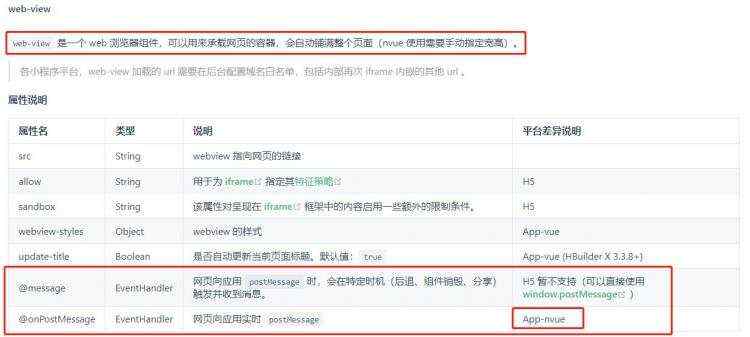作者: | 来源:互联网 | 2023-06-24 10:44
篇首语:本文由编程笔记#小编为大家整理,主要介绍了uniapp实现APP中内嵌H5应用相关的知识,希望对你有一定的参考价值。
现如今,各大APP平台都有属于自己的小程序体系,各种各样的应用都可直接内嵌在APP中实现一站式体验。使用uniapp开发的APP如何实现这样的功能呢?答案就是内嵌web-view
注意事项
-
APP中有vue页面及nvue页面,两种页面均可内嵌web-view,但两种页面的表现不一:vue页面会自动铺满整个页面,接收web-view页面通信使用的是@message;nvue页面则需要指定页面宽高,接收web-view页面通信使用的是@onPostMessage

-
由APP通知web-view页面,无论是vue页面还是nvue页面,只有evalJS方法,但调用的姿势不一致
vue页面调用:
<template>
<web-view :src&#61;"url" &#64;message&#61;"message">web-view>
template>
<script>
export default
xxx,
onLoad()
this.currentWebview &#61; this.$mp.page.$getAppWebview();
this.currentWebview.children()[0].evalJS(&#39;xxx&#39;);
</script>
nvue页面调用&#xff1a;
<template>
<web-view ref&#61;"webview" :src&#61;"url" &#64;message&#61;"message">web-view>
template>
<script>
export default
xxx,
onReady()
this.currentWebview &#61; this.$refs.webview;
this.currentWebview.evalJS(&#39;xxx&#39;);
</script>
- nvue页面中使用的web-view页面是无法调用plus API的&#xff0c;vue页面是可以控制外部web-view页面是否可用plus API&#xff0c;其他事项具体参考web-view | uni-app官网
实现细节
博主使用的是vue页面的web-view组件&#xff0c;因为页面需要铺满屏幕且需要plus API支持&#xff0c;但实现的过程中还是会遇到大大小小的问题&#xff0c;下边举两个具体实现中遇到的问题及解决方案
- 顶部导航栏的表现不一&#xff1a;因内嵌web-view应用需要全屏显示&#xff0c;标题栏也交由内嵌应用自定义&#xff0c;故在pages.json中定义页面的时候&#xff0c;须将页面的
titleNView设置为false。但即便如此&#xff0c;其表现仍然不一致&#xff0c;表现为android端的页面起始位置是手机屏幕的最顶部&#xff08;含状态栏在内&#xff09;&#xff0c;ios端则是从状态栏之下开始渲染页面&#xff0c;为了抹平差异&#xff0c;可使用webview的setStyle统一
APP端设置&#xff1a;
export default
xxx,
onReady()
this.currentWebview &#61; this.$mp.page.$getAppWebview();
let screenRatio, safeAreaInsetsBtm, platform &#61; this.$store.state;
let top &#61; 0;
if (platform &#61;&#61;&#61; &#39;ios&#39;)
let info &#61; uni.getSystemInfoSync();
top &#61; -info.statusBarHeight;
let bottom &#61; safeAreaInsetsBtm / screenRatio;
this.currentWebview.children()[0].setStyle( top, bottom: parseInt(bottom) );
统一两端的top至手机屏幕最顶部&#xff0c;bottom至手机屏幕安全距离之上
内嵌应用中设置&#xff1a;
const actions &#61;
setPage(context)
let statusbarHeight &#61; plus.navigator.getStatusbarHeight();
let pageStyle &#61; paddingTop: &#96;calc(0.2rem &#43; $statusbarHeightpx)&#96; ;
context.commit(&#39;pageStyle&#39;, pageStyle);
;
- 内嵌应用中的数据传递&#xff1a;由APP中调用
evalJS方法&#xff0c;调用到的是内嵌应用index.html中定义的方法&#xff0c;怎么将APP传递过来的信息传递到内嵌应用的vue页面去呢&#xff1f;这里推荐一个插件mitt
APP中调用&#xff1a;
export default
onReady()
this.currentWebview &#61; this.$mp.page.$getAppWebview();
this.currentWebview.children()[0].evalJS("showTip(&#39;提示测试&#39;)");
内嵌应用的index.html中&#xff0c;引用下载到本地的mitt.umd.js&#xff1a;
DOCTYPE html>
<html lang&#61;"en">
<head>
<meta charset&#61;"utf-8" />
<meta http-equiv&#61;"X-UA-Compatible" content&#61;"IE&#61;edge" />
<meta name&#61;"renderer" content&#61;"webkit" />
<meta name&#61;"viewport" content&#61;"width&#61;device-width, user-scalable&#61;no, initial-scale&#61;1.0, maximum-scale&#61;1.0, minimum-scale&#61;1.0" />
<script src&#61;"<%&#61; BASE_URL %>libs/uni-app/uni.app.webview.1.5.2.js">script>
<script src&#61;"<%&#61; BASE_URL %>libs/mitt/mitt.umd.js">script>
<title>xxxtitle>
head>
<body>
<noscript>
<strong>当前浏览器版本太低&#xff0c;请升级浏览器或使用其他浏览器strong>
noscript>
<div id&#61;"app">div>
<script>
window.bus &#61; window.mitt();
const showTip &#61; (tip) &#61;>
window.bus.emit(&#39;showTip&#39;, tip);
;
script>
body>
html>
内嵌应用vue页面中&#xff1a;
export default
activated()
window.bus.on(&#39;showTip&#39;, (tip) &#61;>
alert(tip);
);
deactivated()
window.bus.off(&#39;showTip&#39;);
总结
在实现的过程中&#xff0c;其实不单单只有这些内容&#xff0c;具体的实现还是需要各位真枪实弹编码踩坑&#xff0c;才能知道原来这里面还有这么细节的东西。只能感慨跨端确实不容易啊&#xff0c;继续加油吧&#xff0c;Keep learning…